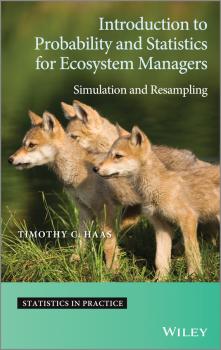Timothy Haas C.
Список книг автора Timothy Haas C.Introduction to Probability and Statistics for Ecosystem Managers. Simulation and Resampling
Explores computer-intensive probability and statistics for ecosystem management decision making Simulation is an accessible way to explain probability and stochastic model behavior to beginners. This book introduces probability and statistics to future and practicing ecosystem managers by providing a comprehensive treatment of these two areas. The author presents a self-contained introduction for individuals involved in monitoring, assessing, and managing ecosystems and features intuitive, simulation-based explanations of probabilistic and statistical concepts. Mathematical programming details are provided for estimating ecosystem model parameters with Minimum Distance, a robust and computer-intensive method. The majority of examples illustrate how probability and statistics can be applied to ecosystem management challenges. There are over 50 exercises – making this book suitable for a lecture course in a natural resource and/or wildlife management department, or as the main text in a program of self-study. Key features: Reviews different approaches to wildlife and ecosystem management and inference. Uses simulation as an accessible way to explain probability and stochastic model behavior to beginners. Covers material from basic probability through to hierarchical Bayesian models and spatial/ spatio-temporal statistical inference. Provides detailed instructions for using R, along with complete R programs to recreate the output of the many examples presented. Provides an introduction to Geographic Information Systems (GIS) along with examples from Quantum GIS, a free GIS software package. A companion website featuring all R code and data used throughout the book. Solutions to all exercises are presented along with an online intelligent tutoring system that supports readers who are using the book for self-study.
Improving Natural Resource Management. Ecological and Political Models
The decision to implement environmental protection options is a political one. These, and other political and social decisions affect the balance of the ecosystem and how the point of equilibrium desired is to be reached. This book develops a stochastic, temporal model of how political processes influence and are influenced by ecosystem processes and looks at how to find the most politically feasible plan for managing an at-risk ecosystem. Finding such a plan is accomplished by first fitting a mechanistic political and ecological model to a data set composed of observations on both political actions that impact an ecosystem and variables that describe the ecosystem. The parameters of this fitted model are perturbed just enough to cause human behaviour to change so that desired ecosystem states occur. This perturbed model gives the ecosystem management plan needed to reach desired ecosystem states. To construct such a set of interacting models, topics from political science, ecology, probability, and statistics are developed and explored. Key features: Explores politically feasible ways to manage at-risk ecosystems. Gives agent-based models of how social groups affect ecosystems through time. Demonstrates how to fit models of population dynamics to mixtures of wildlife data. Presents statistical methods for fitting models of group behaviour to political action data. Supported by an accompanying website featuring datasets and JAVA code. This book will be useful to managers and analysts working in organizations charged with finding practical ways to sustain biodiversity or the physical environment. Furthermore this book also provides a political roadmap to help lawmakers and administrators improve institutional environmental management decision making.

